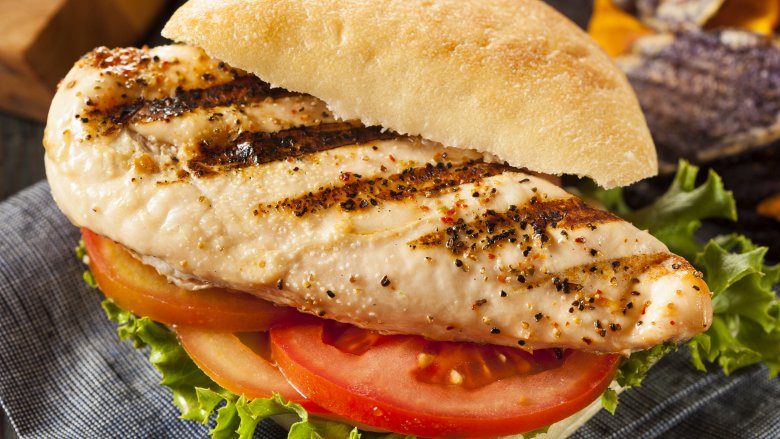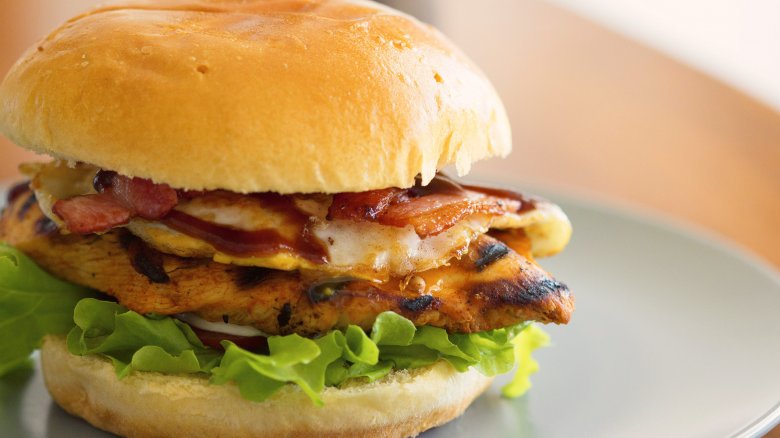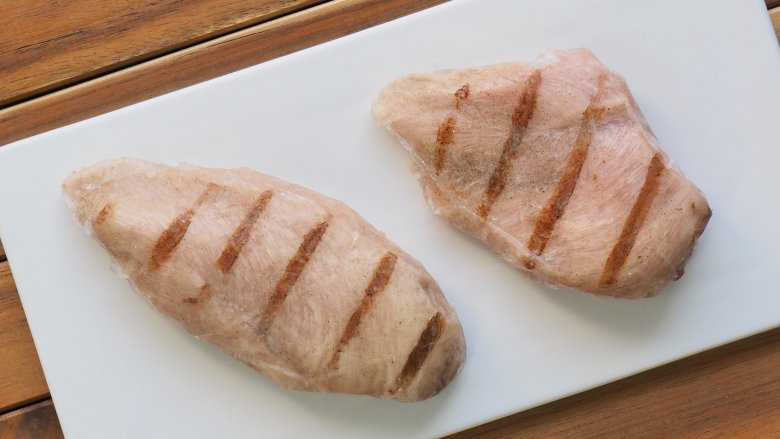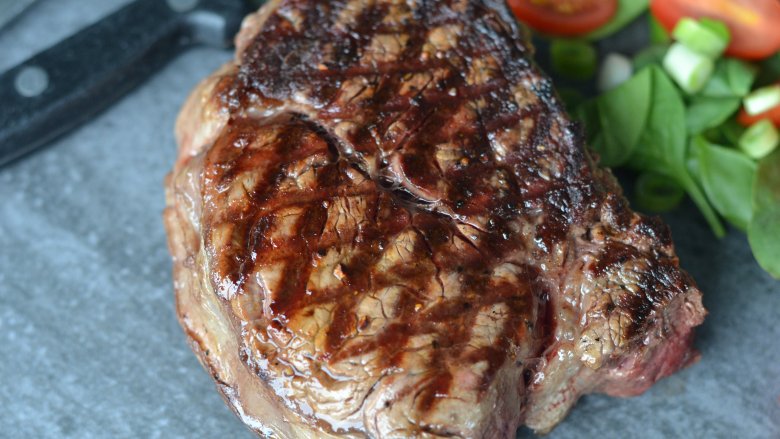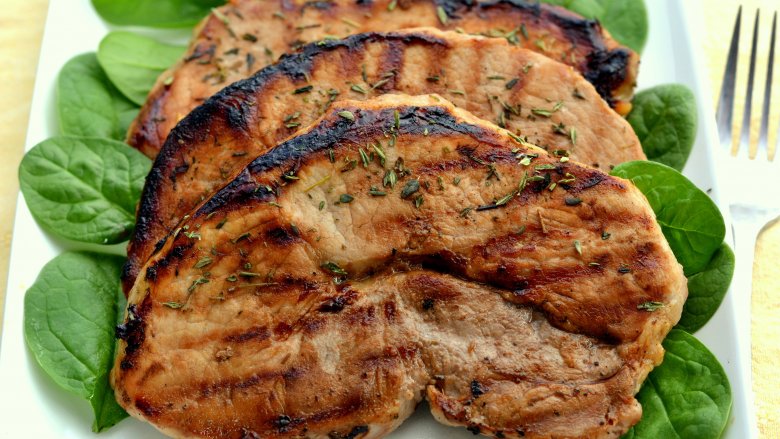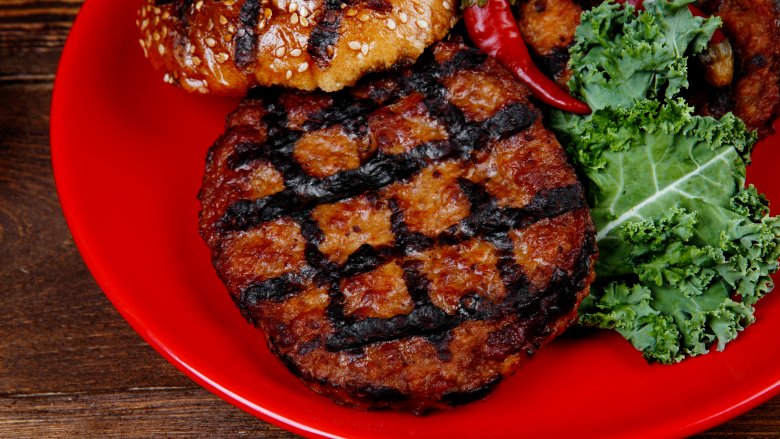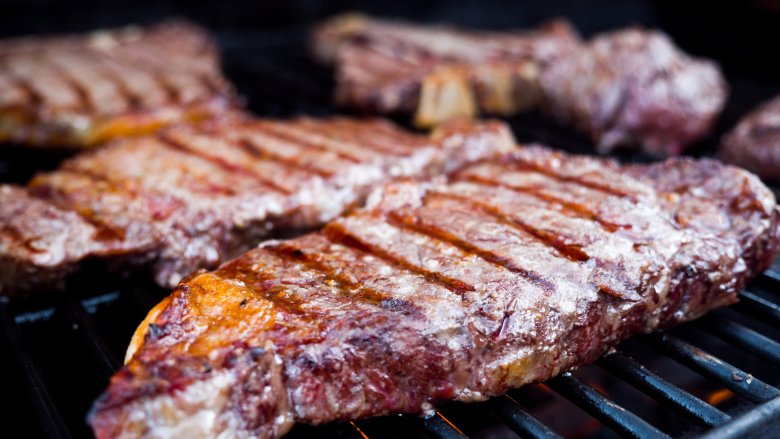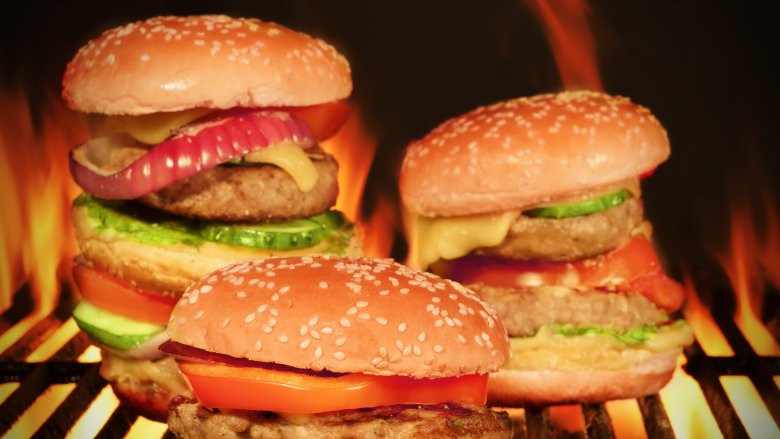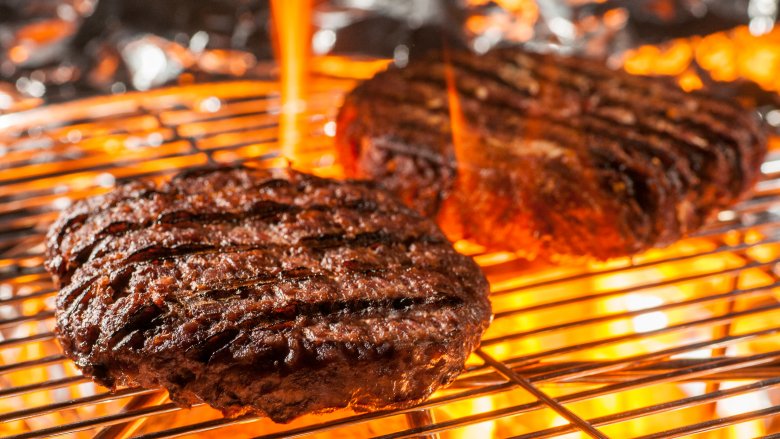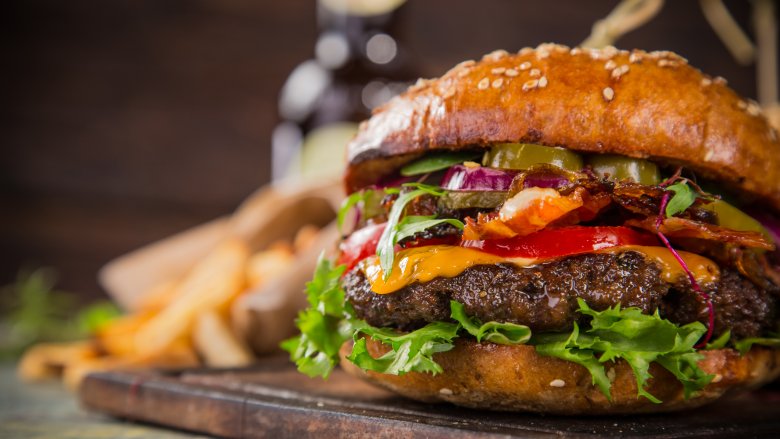Why Fast Food Restaurants Put Fake Grill Marks On Food
You don't have to be a foodie or a grill master to know it: Meat just tastes better after it's been cooked over a charcoal flame. (Sure, gas grills come close, but you know it's not the same.) There's just no contest between the burger you've cooked in a pan on the stove in the dead of winter when you're craving a little summertime food fix and the burger you actually grill out on the back porch, is there?
But what about when you hit up your favorite fast food place, order a burger, and peek under the bun to see that there's grill marks there? Is it a little hoping against hope that somewhere back in the kitchen there's someone manning a grill, tossing on burgers to order? You know it's not true, but they still insist on doing it. Like they're fooling anyone, right? So, if they know it doesn't actually make your burger taste of summer afternoons and fun in the sun, and they're not pulling the wool over anyone's eyes, why do they still insist on doing it? Does everyone do it? Let's find out.
Because we all think it's going to taste better
There's a little bit of psychology going on here, and if you think that those fake grill marks might be there because restaurants suspect you might think their food tastes better with them, you're absolutely right.
Claudia Ficca is a professional food stylist who has worked with companies like Vogue and Coca-Cola, and she told Thrillist: "It's important to see the grill marks because that is what makes it 'grilled'. Even if the brand uses a smoke flavor and doesn't actually grill the meat, in advertising and on packaging the grill marks work as a visual cue for the consumer."
So, there you have it — the main reason they're there is because we think they make the meat look better. Amazing Ribs calls grill marks — both fake and real — necessary for "all the Instagram hero shots", and says that when you put, say, a few steaks next to each other and one has grill marks while the others don't, it's your immediate response to go for the one that has the marks, because we've been trained to think it's going to taste better.
Does it? No, and we're talking about both real and fake grill marks.
They're on frozen food, too
Before we condemn fast food restaurants alone for this deception, we should clarify that they're not the only ones who do it. A lot of the frozen food you buy in the grocery store — think of things like chicken breasts and burgers — come with those same fake grill marks etched onto the meat.
Ficca says (via Thrillist) that part of the reason for the deception — especially in the frozen food aisle — is that when you're looking at the pictures of a package's contents, a plain, unseared, unlined chicken breast is going to look extraordinarily boring. Imagine, quick, if someone put a plain, monochrome chicken breast on your plate. Yum? Now, imagine the same chicken breast, criss-crossed with grill marks. Much better, right? So it's not surprising that's the package you're going to reach for. Ficca says that's because those grill marks make us think of heat and delicious, charred meat that's gotten some one-on-one attention and definitely hasn't been mass-produced, so when something is mass produced, sticking some grill marks on it is a way of convincing our Pavlovian responses that it's not.
It needs to be prepped for those marks
The idea that fast food places add fake grill marks is a little incorrect, as Food Republic says that most places — like McDonald's, Subway, and Taco Bell — order their meat from a supplier who does all the trickery for them. And it's a whole process, starting with the fact that the meat has to be prepped in order to get the grill marks to stick to the meat. They're just being branded on, after all, so the raw meat has to be conditioned to take the lines.
That's done by either soaking the raw meat in a solution or injecting it directly into the product. What kind of solution are we talking about? Usually, it's a mix of salt, extra animal fat, preservatives, and oftentimes smoke flavoring. That last one makes it taste a little like it was actually grilled over smoke, but more often than not, your pre-cooked patties are being cooked with blasts of hot air.
Just how much of this solution do you end up eating with your sandwich? According to Fast Company, McDonald's Grilled Chicken fillet contains up to 20 percent "solution," and that's something you'll never be able to un-know.
Char-marking is a complicated process
Fast Company says that getting meat and patties with fake char marks is also a money-saving move on the part of the companies that do it. It's much more cost-effective to just buy pre-marked meat than it is to install grills in all their restaurants and hire someone who is only in charge of manning the grill, after all. So, they leave it to the processors to give their meat that chargrilled look.
Even then, it's complicated. Different companies have different methods and machines in place but basically, after the meat has been soaked or injected with solution, it's then transferred to a massive conveyor belt. It's then run through something called an impingement oven — which bakes meat with a blast of hot air — then it's passed over with a machine like the CM-40 II Charmarker. That's essentially a set of branding wheels that burn the desired pattern into the meat, and it takes just a split second to get that oh-so-desirable grill pattern before it hits the freezer.
And that's key. What a machine can do in just a second would take a fast food employee much, much longer, and not only would that slow down the process of getting your burger into your hands, but it would also take that employee away from something else they could be doing. And fast food is all about efficiency.
How grill marks are done for commercials
Ordering something you saw in a TV commercial is always something of a surprise, as what you unwrap never, ever looks like what you saw on TV. That's because there's a whole group of people dedicated to making things look extra good on television: food stylists, the restaurant world's make-up artists.
And according to Mental Floss, they have a ton of tricks in their little make-up bags for food and quite a few of them are used to get meat products looking their best. In addition to throwing a wet-then-microwaved sponge, tampon, or pile of cotton balls behind a burger to give the impression that it's steaming, they'll often also char it with a blowtorch then add grill marks with a branding iron. Sometimes, that's not enough and that final product you're seeing was actually filled in with shoe polish, varnish, or, like Claudia Ficca (via Thrillist) prefers to use, eyeliner. So, look at it this way: Your burger might not look as good as the one you saw on TV, but there's no doubt that it tastes better.
Grill marks are overrated anyway
Here's the ultimate irony: We love the look of grill marks because of what it makes us think of and the incredible flavors it reminds us of, but as Amazing Ribs points out, grill marks aren't all they're cracked up to be and they're not even the best indication that a burger or steak is going to be the best you've ever tasted. Here's why...
Let's use a steak as our example. What's the best part of a steak? It's that super-dark brown crust, right? That crust happens because of something called the Maillard reaction, which is a process that happens during cooking and actually changes the structure of the meat. Hundreds of new compounds are created, and fortunately, they're delicious. In an ideal steak, you want that deep brown color to cover the whole thing, and when all you've got to show are some grill marks and some not-so-dark beef? Well, we hate to break it to you, but you're doing it wrong.
Get deep grill marks on an actual grill and what you've really got is charred, seared lines and underdone sections in the middle that haven't had the chance to work the magic that is the Maillard reaction. Suddenly it doesn't sound so good, does it?
Some grill marks are legit
Pilgrim's Pride has 45 separate lines producing various meat products with fake grill marks, and when VP of marketing Dan Emery was asked (via Fast Company) just who they supplied, he dodged the question with this response: "They don't really like us to name names, but we do 9 of the top 10, all except McDonald's." So that means just about every fast food company slaps fake grill marks onto their meat, right?
A lot of them, yes, but there are exceptions. The New York Times reported back in 2003 that Burger King was going to be refocusing their major advertising campaigns to push the idea that yes, their burgers were cooked over an open flame. Then, there's Chick-fil-A, who relaunched their grilled chicken line of products in 2014 with a high-tech grill that cooked the chicken from both sides at once — and made legitimate grill marks.
There's also plenty of smaller chains — like the 10 locations of Char-Grill — who actually use real grills. QSR says you can head to Carl's Jr. and Hardee's and know they're using flame-grilling machines for their burgers, and that's pretty close, right? The moral of the story is that you can't assume all grill marks are fake, and you might be surprised where the real ones come from.
Wait, what's the difference between fire-grilled and… other "grilled"?
Here's the thing. If so many fast food restaurants want their burgers to have char marks, why not just follow in the footsteps of the places that have figured out how to do it a little more naturally and without all the weird salt-and-chemical solutions?
There's plenty of other options for doing it, after all. QSR notes that "grilling" simply refers to cooking meat on grates over heat, and adds that broiling can result in the same sear, when it's done on a char broiler that uses grates. There's also flame-grilling, and that's where the meat is put on a conveyor belt with heat that comes from above and below.
Hardee's has even used a process called charco-broiling, which meant burgers were cooked over "char rocks." Fat and drippings from the burger would drop down on the rocks and add to the unique taste of their burgers. So yes, there are a ton of other options that don't involve fake grill marks, so if you're uncomfortable with the idea of eating a burger that's a good percentage mystery solution, alternatives are out there.
Will this trickery disappear?
Social media's impact on America's food culture is a fascinating thing, and Business Insider says it's been responsible for a lot of terrible things. It's made people value pretty food over food that actually tastes good, but might not be quite so photogenic. And that, of course, is where our grill marks come in. They definitely make that chicken breast look a little better in photos, but they don't actually do anything else.
And here's the thing — there might be a little hope on the horizon, especially for less-than-perfect food and dishes that aren't quite as photogenic as your favorite A-list celebrity: There's a push in the opposite direction.
Trends on Instagram suggest that people are becoming more in-tune to the story behind the food instead of appearances alone. And that includes a lot, covering things like nutritional value, taste, and whether or not there's artificial ingredients in a dish. Fake grill marks aren't necessarily an artificial ingredient, but they definitely are artificial and solely for the sake of appearances. Does that mean we're beginning to value honesty over appearances? Will fake grill marks become a thing of the past, another weird relic of the early 21st century that our grandchildren will laugh at someday? Maybe!
